The Intel 6th Gen Skylake Review: Core i7-6700K and i5-6600K Tested
by Ian Cutress on August 5, 2015 8:00 AM ESTWhat You Can Buy: Gaming Benchmarks on the High End
Alien: Isolation
If first person survival mixed with horror is your sort of thing, then Alien: Isolation, based off of the Alien franchise, should be an interesting title. Developed by The Creative Assembly and released in October 2014, Alien: Isolation has won numerous awards from Game Of The Year to several top 10s/25s and Best Horror titles, ratcheting up over a million sales by February 2015. Alien: Isolation uses a custom built engine which includes dynamic sound effects and should be fully multi-core enabled.
For low end graphics, we test at 720p with Ultra settings, whereas for mid and high range graphics we bump this up to 1080p, taking the average frame rate as our marker with a scripted version of the built-in benchmark.
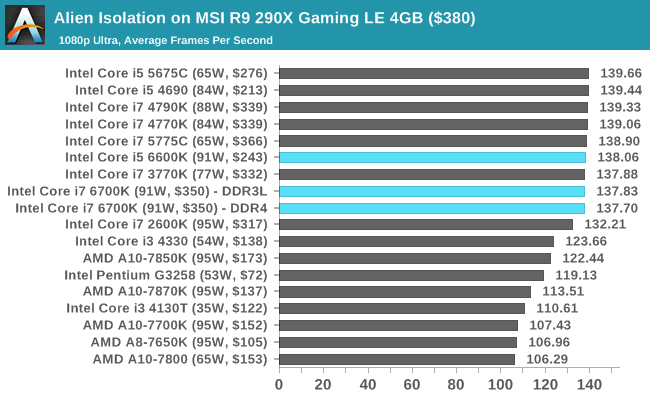
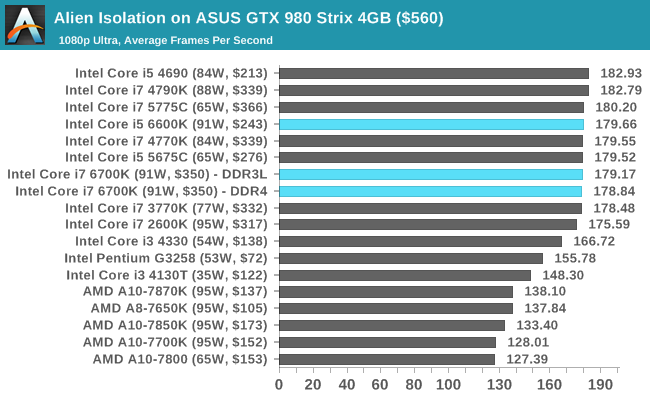
Total War: Attila
The Total War franchise moves on to Attila, another The Creative Assembly development, and is a stand-alone strategy title set in 395AD where the main story line lets the gamer take control of the leader of the Huns in order to conquer parts of the world. Graphically the game can render hundreds/thousands of units on screen at once, all with their individual actions and can put some of the big cards to task.
For low end graphics, we test at 720p with performance settings, recording the average frame rate. With mid and high range graphics, we test at 1080p with the quality setting. In both circumstances, unlimited video memory is enabled and the in-game scripted benchmark is used.
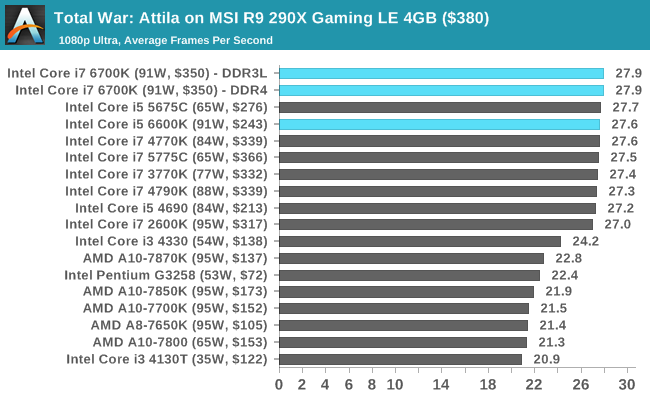
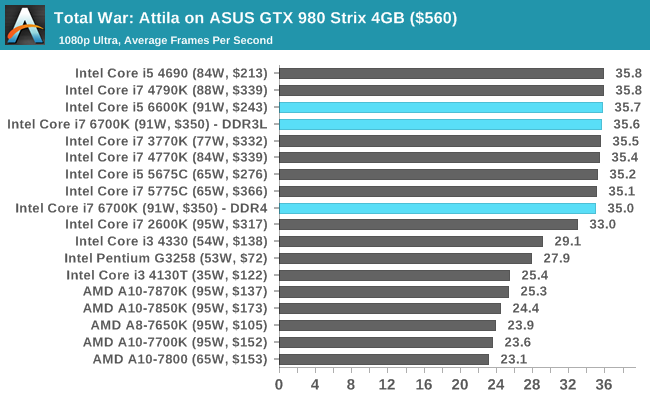
Grand Theft Auto V
The highly anticipated iteration of the Grand Theft Auto franchise finally hit the shelves on April 14th 2015, with both AMD and NVIDIA in tow to help optimize the title. GTA doesn’t provide graphical presets, but opens up the options to users and extends the boundaries by pushing even the hardest systems to the limit using Rockstar’s Advanced Game Engine. Whether the user is flying high in the mountains with long draw distances or dealing with assorted trash in the city, when cranked up to maximum it creates stunning visuals but hard work for both the CPU and the GPU.
For our test we have scripted a version of the in-game benchmark, relying only on the final part which combines a flight scene along with an in-city drive-by followed by a tanker explosion. For low end systems we test at 720p on the lowest settings, whereas mid and high end graphics play at 1080p with very high settings across the board. We record both the average frame rate and the percentage of frames under 60 FPS (16.6ms).
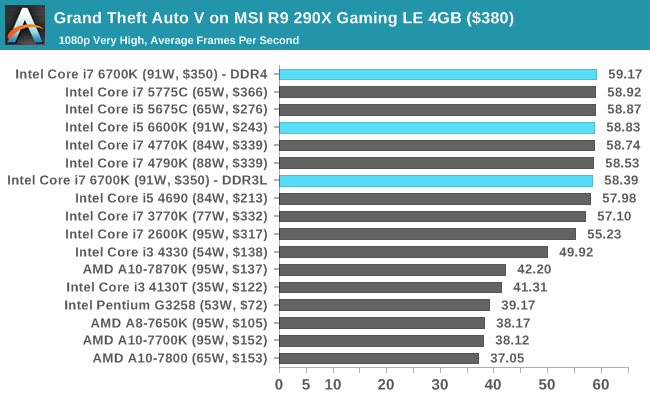
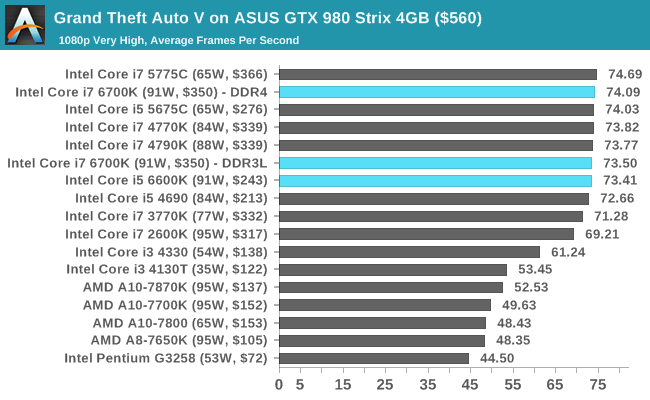
GRID: Autosport
No graphics tests are complete without some input from Codemasters and the EGO engine, which means for this round of testing we point towards GRID: Autosport, the next iteration in the GRID and racing genre. As with our previous racing testing, each update to the engine aims to add in effects, reflections, detail and realism, with Codemasters making ‘authenticity’ a main focal point for this version.
GRID’s benchmark mode is very flexible, and as a result we created a test race using a shortened version of the Red Bull Ring with twelve cars doing two laps. The car is focus starts last and is quite fast, but usually finishes second or third. For low end graphics we test at 1080p medium settings, whereas mid and high end graphics get the full 1080p maximum. Both the average and minimum frame rates are recorded.
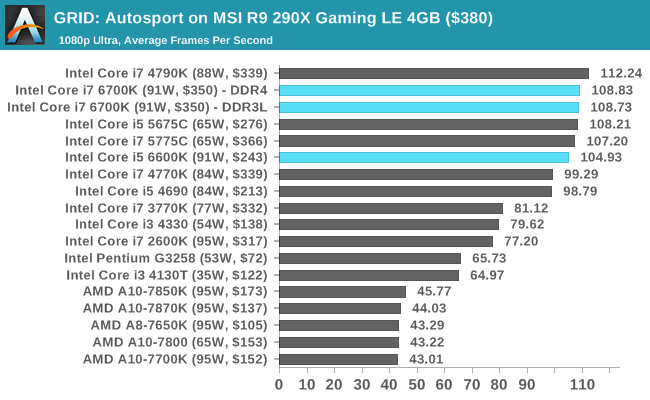
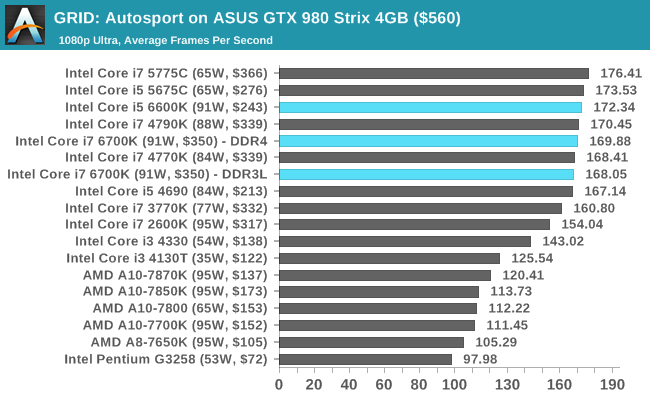
Middle-Earth: Shadow of Mordor
The final title in our testing is another battle of system performance with the open world action-adventure title, Shadow of Mordor. Produced by Monolith using the LithTech Jupiter EX engine and numerous detail add-ons, SoM goes for detail and complexity to a large extent, despite having to be cut down from the original plans. The main story itself was written by the same writer as Red Dead Redemption, and it received Zero Punctuation’s Game of The Year in 2014.
For testing purposes, SoM gives a dynamic screen resolution setting, allowing us to render at high resolutions that are then scaled down to the monitor. As a result, we get several tests using the in-game benchmark. For low end graphics we examine at 720p with low settings, whereas mid and high end graphics get 1080p Ultra. The top graphics test is also redone at 3840x2160, also with Ultra settings, and we also test two cards at 4K where possible.
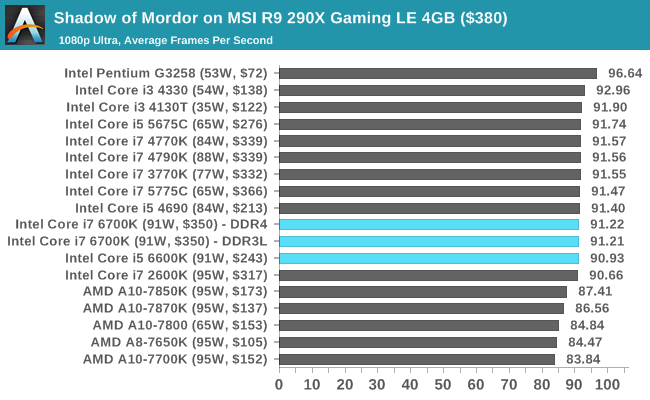


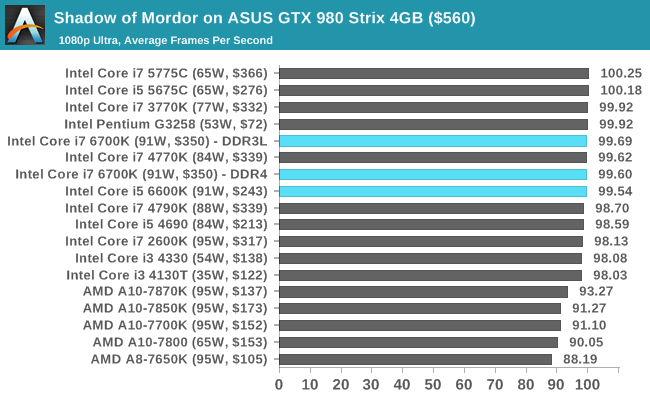
















477 Comments
View All Comments
Sunburn74 - Wednesday, August 5, 2015 - link
Still not budging from my 2600K. There is no evidence of real world benefit of an PCIE drive compared to a sata drive. As for the CPUs, the 25% gain IS impressive considering the short time period it has been accomplished in but is just within the threshold of noticeability. Would prefer to wait till maybe 50% gain or when software really starts to take advantage of SSDs.Pneumothorax - Wednesday, August 5, 2015 - link
You're giving Intel too much slack here. Even the much maligned P4 generations had a 50% improvement in raw speed in 2 years. We've waited almost 4 years for only 25%. What's crazy is it cost Intel billions of R&D for it.heffeque - Wednesday, August 5, 2015 - link
25% in 4 yeas... but their iGPU now has more Dx12 Tier 3 support than nVidia and AMD.Nagorak - Wednesday, August 5, 2015 - link
Unfortunately, no serious gamer will ever use it.Bambooz - Wednesday, August 5, 2015 - link
"in my experience all computers are a bit unstable"in other words: you've been buying shitty components :)
kmmatney - Wednesday, August 5, 2015 - link
OK, come on! You bought a "K" cpu - it's meant to overclock - at least bump it up to 4.2-4.3 Ghz - it will run that without any voltage increase. In fact, most motherboards (mine included) seem to overvolt Devil's Canyon cpus, even at stock voltage. In fact, you can probably undervolt it, and overclock it at the same time, as Anandtech did here:You have a guide handed to you for overclocking this cpu:
http://www.anandtech.com/show/8227/devils-canyon-r...
My Z97 PC-Mate motherbard was setting my i5 4690K at 1.2V while at stock, which is higher than it needs - it can run at 4.5Ghz at that setting!
IUU - Saturday, August 8, 2015 - link
I agree with the upgrading part.But not quite with the 25% IPC increase. 25% is awesome.
Two important things:1. It carries the burden of a useless gpu. It could either consume
less energy or the same with more cores. At least then you would use the cpu
where possible for what it's meant to be used.
2. the 25 % increase is the "real" world performance. Unfortunately the "real" world is terribly
slow to take advantages of the improvement Intel introduces with the new instruction sets.
So while it's good to stay down to earth to the "real" world performance, it would be nice to have also a mention of the theoretical improvements of the cpu.
icebox - Wednesday, August 5, 2015 - link
I still don't see the reason to upgrade from a 2600k even though I really urge to upgrade my hardware :) I really don't care about integrated graphics and I'm pretty sure 80% buyers of i7 k parts don't either.There was no reason when ivy brought 5 percent, haswell another 10% and devil 5% more. Now it's a total of 25%. I want more from a total platform change - I moved from 755 to 1155 for a lot more than that. Mainly I want more than 16 PCI lanes, I understand they'll never give us more than 4 cores because xeon and E series.
euler007 - Wednesday, August 5, 2015 - link
Same here, I'm always waiting every generation upgrade my OC'ed 2500k, but I mainly use my home rig for gaming and these benchmarks give me no reason to upgrade. Maybe Skylake-E.moerg - Wednesday, August 5, 2015 - link
so DDR4 offers nothing in gaming?